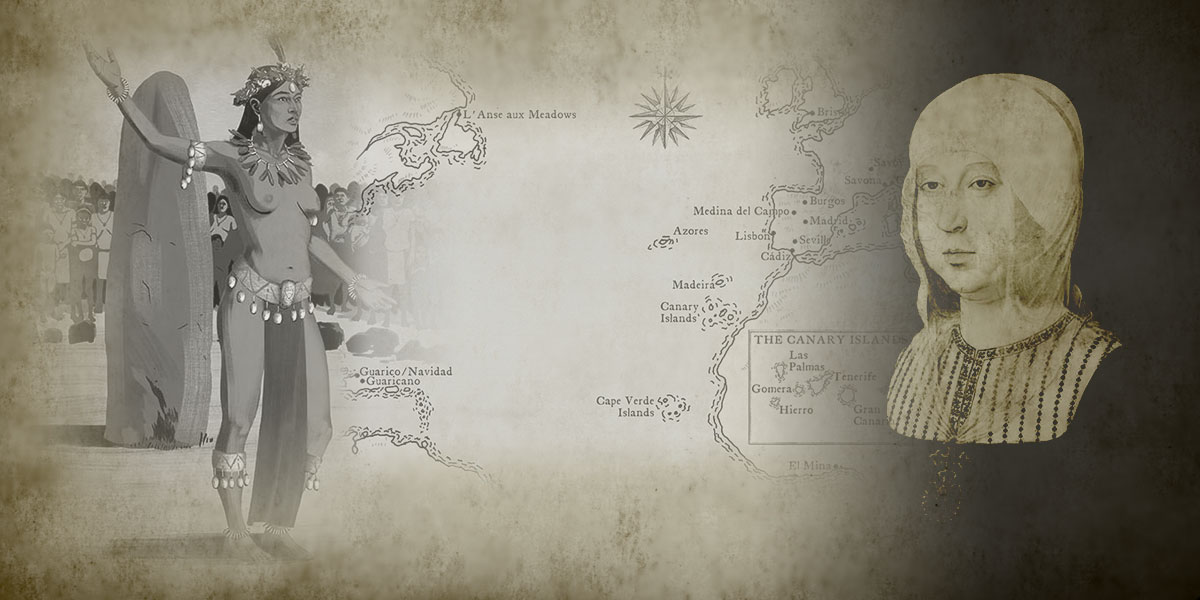
Andrew’s Current Blog
Archived blogs chronicling 1492 from a bicultural perspective appear under 1492 Blogs.
Andrew’s Current Blog
Archived blogs chronicling 1492 from a bicultural perspective appear under 1492 Blogs.
Chief Behecchio
When Columbus arrived at the Caribbean in 1492, Chief Behecchio ruled Xaraguá, one of “Española’s” five principal chiefdoms. Located in the island’s southwest portion, Xaraguá was then admired for its large population and abundant crops and the civility of its daily...
Gold Fuels Conquest
As discussed in the prior post, gold was a key expectation driving Queen Isabella’s conquest of “Española.” That expectation waned and resurged during the period from 1493 to 1502, affecting the desire and willingness of her Spanish ministers, financiers, and subjects...
Conquest for Gold
A key expectation driving Queen Isabella and King Ferdinand’s conquest of “Española” was that Columbus would find and ship its gold home to them, as he promised repeatedly from 1493 to 1500. In 1499, placer gold was finally discovered in quantity in the watershed of...
Battle of Ciguayo, Mayobanex and Bartolomé Colón
The next sequel will depict the brutal three-month war fought in 1498 in the chiefdom of Ciguayo on “Española’s” northern coast. Chief Guarionex had sought the protection of the Ciguayan Chief Mayobanex, and Mayobanex refused to surrender him when Columbus’s brother...
Corocote
For Valentine’s Day, I post about the Taíno spirit of romance, sexual delight, and virility, Corocote, and some counterparts in other cultures. According to Fray Ramón Pané, Corocote sits on top of bohíos and comes down at night to lie with the women sleeping within....
Adamanay (Saona Island)
On my recent trip to the Dominican Republic, I took a boat trip to Saona Island at the DR’s southeastern tip, the site of several events depicted in my books. The historic Taíno name for the island was Adamanay, and its local chieftains likely were vassal to the...
Columbus’s Demise
The next sequel will depict Columbus’s demise over the years 1498 through 1502, including his struggle to settle the rebellion against his rule of “Española” led by Francisco Roldán and Queen Isabella and King Ferdinand’s decision to remove him as the island’s...
Statues and Illustrations of Anacaona
I returned from visiting the Dominican Republic last week, completing my research for the next sequel. It will retell the years 1498 to 1502, depicting Anacaona’s then successful struggle to maintain rule of her and her brother’s chiefdom despite “Española’s” conquest...
Portraits and Statues of Queen Isabella
I’ve just returned from a trip to Spain, and I’ll visit the Dominican Republic next month, completing my research for the next sequel. The book will retell the years 1498 to 1502, depicting Queen Isabella’s sincere but failed effort to curtail her conquerors’ abuses...
Caonabó, Anacaona, and Enriquillo
In advance of Indigenous Peoples’ Day, I post photos of busts of Chiefs Caonabó, Anacaona, and Enriquillo, portions of statues in the Dominican Republic (San Juan de la Maguana for Caonabó and Anacaona, south of Lake Enriquillo for Enriquillo). As my published books...
